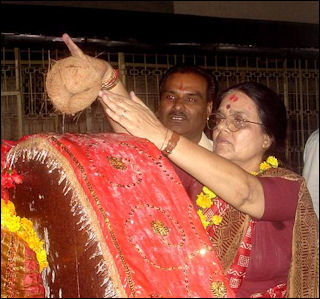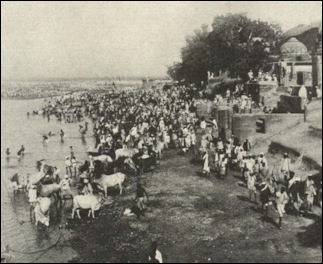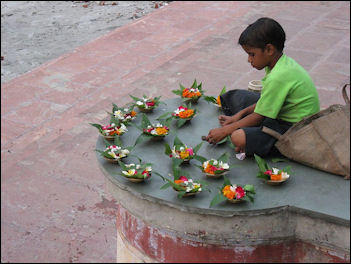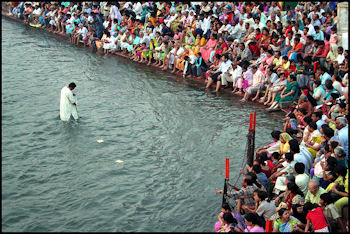THINGS THAT ARE SCARED TO HINDUS

Pouring Ganges Holy water According to the “Worldmark Encyclopedia of Religious Practices”: India is sacred to Hindus, and its mountains, rivers, and other physical features are revered. The mere sight of the Ganges, which flows from the Himalayas across the northern plains and into the Bay of Bengal, is considered beneficial. It is believed to be particularly auspicious to be cremated along the river's banks or to have one's ashes immersed in its waters. Mountains, particularly the Himalayas, are venerated as abodes of the gods. [Source: Leona Anderson, “Worldmark Encyclopedia of Religious Practices”, Thomson Gale, 2006]
Hindus worship spirits and godlings of rivers, mountains, vegetation, animals, stones, or disease. Ritual bathing, vows, and pilgrimages to sacred rivers, mountains, shrines, and cities are important practices.The Golden Fishes (gser-na) originally represented the two main sacred rivers of India — the Ganges and the Yamuna. These rivers are associated with the lunar and solar channels that originate in the nostrils and carry the alternating rhythms of breath or prana (life-sustaining force).
The worship of rivers and mountains can be viewed as good examples of the “little tradition” of Indian religion, as distinguished from the religion of the "great tradition". The great (or Sanskritic) tradition, sometimes called Brahmanism, developed under the leadership of Hinduism's highest caste group, the Brahmans, who as the traditional priests, teachers, and astrologers enjoy numerous social privileges. The great tradition preserves refined and abstract philosophical concepts that exhibit very little regional variation. At this level, there is emphasis on unity in diversity and a pervasive attitude of relativism. [Source: Library of Congress *]
On the level of the little tradition, Hinduism admits worship of spirits and godlings of rivers, mountains, vegetation, animals, stones, or disease. Ritual bathing, vows, and pilgrimages to sacred rivers, mountains, shrines, and cities are important practices. An ordinary Hindu will worship at the shrines of Muslim pirs, without being concerned with the religion to which that place is supposed to be affiliated. Hindus revere many holy men and ascetics conspicuous for their bodily mortifications. Some people believe they attain spiritual benefit merely by looking at a great holy man.*
RECOMMENDED BOOKS:
"An Introduction to Hinduism" by Gavin Flood Amazon.com ;
“Hinduism for Beginners - The Ultimate Guide to Hindu Gods, Hindu Beliefs, Hindu Rituals and Hindu Religion” by Cassie Coleman Amazon.com ;
“Hindu Myths: A Sourcebook” translated from the Sanskrit by Wendy Doniger (Penguin Classics, 2004) Amazon.com ;
“India: A History" by John Keay Amazon.com ;
“The Rig Veda” by Anonymous and Wendy Doniger (Penguin Classics) Amazon.com ;
"The Hindus: An Alternative History" by Wendy Doniger; Amazon.com ;
“The Upanishads” by Anonymous and Juan Mascaro (Penguin Classics) Amazon.com ;
“The Bhagavad Gita” by Anonymous and Laurie L. Patton (Penguin Classics)
Amazon.com ;
“Myths and Symbols in Indian Art and Civilization” by Heinrich Zimmer (Princeton University Press, 1992) Amazon.com
Holy Hindu Rivers
Hindus regard India as the Holy Land. There are seven holy rivers in India, of which the Ganges is the holiest and most well known. They are all associated with Shiva. According to one legend, Shiva leaped in the water of the Ganges as it fell from heaven to the earth. The water matted his hair and divided into the seven holy rivers.
Rivers are regarded as sacred and treated with deep reverence because of their purifying effect. Bathing in a sacred river and/or drinking its waters can wash away a lifetime's worth of sins and being cremated on the shores of holy river and having your ashes thrown in the river can allow you to escape the cycle or reincarnation of be delivered directly to heaven.
For many Indians the Narmada River is just as sacred as the Ganges. Lepers have claimed to be cured after taking a dip in it. Every year thousand of Hindu pilgrims perform a “pradakshina” of the Narmanda and walk every inch of both banks. The Brahmaputra in Hindu cosmology is the only male river.
Ganges
The Ganges flows for 1,560 miles from the Himalayas in the north to the Bay of Bengal in the south. It drains an area of 450,000 square miles and directly affects the lives of 300 million people. The Ganges Plain which was covered by a shallow sea as recently as 10,000 years ago. A third of India's people (200 million) live in the Ganges Plain, where the population averages over 1,000 people per square mile, one of the highest in the world.
On the banks of the Ganges and other river you will see dhoti-clad men doing yogic push ups, wrestling or swing huge stone-headed clubs over their head. At Hindu temples along the Ganges pilgrims bathe in the water, make offerings, touch the temple walls, ask advice of sadhus, receive blessing from priest and gather water in jugs to take home.
The Ganges is named after Ganga, a river goddess who descended from heaven and had her fall broken by Shiva’s hair. She is the second wife of Shiva. Her sisters are Yamuna, Godavari, Saraswati, Narmada, Sindhu and Kaveri. Prayers honoring all these holy relatives are recited in the holy river when the bathers submerge themselves to be purified. The Ganges is sometimes referred to as "the liquified from of God."
Ganges and Hinduism

Ganges Bathing Fair For Hindus the Ganges is the sacred river known as Gangaji, or Mother Ganges. It is comprised of amrita (“the nectar of immortality”) that flows to earth from heaven. Hindus believe that bathing and/ or drinking it waters can wash away a lifetime's worth of sins. Being cremated on its shores and having one’s ashes thrown in the river can allow one to escape the cycle or reincarnation of be delivered directly to heaven.
Ganga represents fertility because she provides water for land and is considered a second wife of Shiva. She is often depicted with a bowl of water in one hand and lotus flower in another, sitting on a makara, a legendary sea monster.
The Ganges is regarded as the link between heaven and earth. In one Hindu story, the Ganges fell from the foot of Vishnu, the preserver, and traveled across the Milky Way before getting lodged in the foot of Shiva, the destroyer and restorer. On top of mythical Mount Meru in the Himalayas, Shiva calmed the river and let it fall to earth.
In another story, the Ganges River was created by the goddess Ganga to wash away the condemned souls of King Sagar's 60,000 sons who had been burned to a crisp by the gaze of the sage Kapali. The sons had cursed Kapali of stealing their father's horse (which had placed in the sage’s ashram by the mischievous thunderstorm god Indra). Ganga was summoned by King Sagar and the god Shiva was called in to catch Ganga, lest she wash away the entire earth. Shiva ensnared her in his hair — the Himalayas — and she remained their until she managed to escape near Gangotri, where upon she dropped from the mountains and flowed to the sea redeeming the souls of the Sagar's 60,000 sons.
Bathing in the Ganges

Hindus bath in, drink and throw the cremated ashes of the dead in the Ganges. Sprinkling holy water from the Ganges over one's head is believed to wash away sins, purify unclean souls and heal the sick. Bathing in the Ganges even once is supposed to ensure salvation. If a person dies in the Ganges or a has a few drops of Ganges placed on his tongue as he breaths his last breath it is believed he will achieve absolute salvation, escape the toil of reincarnation and be transported to Shiva's Himalayan version of heaven.
Every morning Hindus gather on the shores of the Ganges to bathe and pray for liberation from the world. The pouring of marigolds into the Ganges is a traditional peace offering. The river carries the petals to the oceans and the far corners of the world, carrying the promise of peace with them. Many people collect water from the Ganges in bottles. Some devoted Hindu take Ganges water to drink when they travel abroad.
According to the maharajah of Varanasi. "It is only after my ritual bath and while I am eating that I cannot touch anyone other than members of my household who have performed the same purification rituals. To do so would make me ritually impure. But goodness does not come only by touching and eating with people; it comes from much more.” [Source: John Putman, National Geographic October 1971]
Mt. Meru

Kailash, Mt. Meru Reincarnation is the transmigration of the soul from one life form to another. It doesn’t just apply to humans but to all creatures and some non-living things too. Transmigration of the soul can take place from a human or creature into another human or creature up or down a scale based on good and evil deeds (See Karma Below). If a person has lived a virtuous life he moves up the scale, say, from a low caste to a high caste. If a person has lived an unworthy life he moves down the scale, say, from a low caste to a rat.
Reincarnation is a belief found in most Asian religions and is a cornerstone of all the major religions found in India except Islam. The Hindu idea of reincarnation is roughly the same regardless of which Hindu god an individual venerates most.
The Hindu concept of reincarnation first appeared in the Upanishads and is believed to have originated in the Ganges Plain and was absorbed b the Aryan-centered Hinduism as the Aryans moved into the Ganges Plain. Beliefs in reincarnation are not just found in India and Asia but are found in tribal cultures all over the world and were held by the ancient Greeks, Vikings and other groups in the West. Ideas about reincarnation are probably very old and were held by people who lived in Neolithic times.
Hinduism and Science
Gadadhara Pandit Dasa, an author and meditation facilitator, wrote in the Huffington Post: “Some would comment that faith is only necessary when it comes to matters of religion and that science is based on empirical evidence. Although this sounds nice, it’s not 100 percent accurate. For example, we all believe in the existence of the atom. But how many people on the planet have actually seen an atom with their own eyes? I’m not in any way denying the existence of the atom. Nor do I dis-believe the people who have measured its existence. The point made here is that we are placing faith in those who have done the experiment and we are accepting their results. The masses are placing faith in the few who have done the experiment. [Source: Gadadhara Pandit Dasa, Huffington Post, September 20, 2011]
“Another item we place implicit faith in is the “Big Bang Theory,” which tells us that the universe began 15-20 billion years ago from a single point. Who can prove to us the reality of a phenomena that took place tens of billions of years ago? There’s no instant replay when we’re dealing with life and time. We can’t be shown what happened that far in the past. There may be some evidence and reason to believe that this is how it happened, but at the end of the day we can’t know for sure and that’s where faith comes in.
“In a recent article, in the U.S. News and World Report, physicist Roger Penrose theorized that the Big Bang might be one in a cycle of such events, suggesting that the universe has had multiple existences. This is common knowledge to one familiar with Vedic philosophy and cosmology, which very clearly indicates that the universe has had many births and deaths. The centuries-old wisdom of the Vedic texts doesn’t stop there. They claim that our universe is just one of many universes, a concept entertained by modern science and referred to as “the multiverse theory.” The description given is that our universe is one mustard seed in a bag full of a practically uncountable number of mustard seeds. This concept is toyed with in famous Hollywood movies such as “Contact” and “Men In Black.”

public prayer in Haridwar “In the West, Einstein is credited with the Theory of Relativity. However, one might be quite surprised to learn that there are multiple examples of it in the Puranic texts of India. Einstein’s hypothetical experiment known as the “twin paradox” suggests that if one of a pair of twins travels to outer space at high speed, while the other remains on earth, when the space traveling twin returns, he will be younger than his counterpart on earth.
“The following passages from the Bhagavat Purana communicates the relativity of time: “One’s life endures for only one hundred years, in terms of the times in the different planets... Eternal time is certainly the controller of different dimensions, from that of the atom up to the super-divisions of the duration of Brahma’s life; but, nevertheless, it is controlled by the Supreme. Time can control only those who are body conscious, even up to the Satyaloka or the other higher planets of the universe.”
“There is also a story from the Puranas which parallels Einstein’s hypothetical experiment. A yogi, upon exiting the earthly realm for the higher planetary realms, was informed by the inhabitants of these higher realms that millions of years had instantly passed on Earth in the mere moments since he had entered the higher realms. They also told him that all of his relatives and everyone he had ever known was deceased. We can pass this off as myth or fable, but one should ponder how these texts of ancient India are coming up with concepts that are so close to modern scientific theories.
“There is a wonderful synergy between science and spirituality within the Vedic tradition, and I don’t believe there is a real border dividing them. It’s all just wisdom and knowledge, which is what the term Veda means. These are all truths that are meant to inform us of the world and universe we inhabit so that we can understand our place in it. These truths help us to ultimately transcend the realm of matter, shed the material body we inhabit and endeavor to re-enter the spiritual realm.”
Image Sources: Wikimedia Commons
Text Sources: “World Religions” edited by Geoffrey Parrinder (Facts on File Publications, New York); “Encyclopedia of the World’s Religions” edited by R.C. Zaehner (Barnes & Noble Books, 1959); “Encyclopedia of the World Cultures: Volume 3 South Asia “ edited by David Levinson (G.K. Hall & Company, New York, 1994); “The Creators” by Daniel Boorstin; “A Guide to Angkor: an Introduction to the Temples” by Dawn Rooney (Asia Book) for Information on temples and architecture. National Geographic, the New York Times, Washington Post, Los Angeles Times, Smithsonian magazine, Times of London, The New Yorker, Time, Newsweek, Reuters, AP, AFP, Lonely Planet Guides, Compton’s Encyclopedia and various books and other publications.
Last updated September 2018
